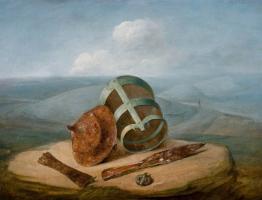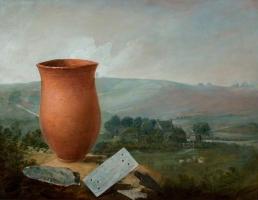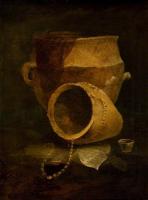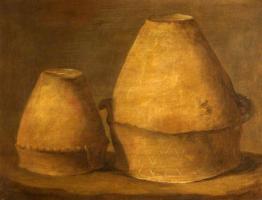Text this colour links to Pages. Text this colour links to Family Trees. Place the mouse over images to see a larger image. Click on paintings to see the painter's Biography Page. Mouse over links for a preview. Move the mouse off the painting or link to close the popup.
Winterslow Barrow 223320 is in Winterslow, Wiltshire [Map].
Winterslow Barrow 223320 [Map]. A Bronze Age bell barrow, part of the Winterslow Hut Barrow Group, situated to the northwest of 'The Pheasant'. The barrow was designated as Idmiston 23 by Grinsell (1957) and survives as an earthwork 30 metres in diameter and 3.5 metres high. The mound is not situated within the centre of the ditched area, as the berm varies from 9 metres to 12 metres in width. The ditch is visible both as an earthwork and a cropmark, is 4 metres wide and up to 0.2 metres in depth. Excavations by the Rev. A.B Hutchins in 1814 located an intrusive Saxon inhumation accompanied by a shield, spear, buckle and a bucket. The grave goods give a 5th or 6th century date for the burial.

1814. Thomas Guest (age 33). Grave Group from a Surface Interment at Winterslow Barrow 223320 [Map]. The bucket, shield boss and grip, spearhead and bronze brooch date to the Saxon period. They are from a surface interment (burial) in the Winterslow 'colossal barrow', which is possibly pictured behind the grave goods.

1814. Thomas Guest (age 33). Grave Group from a Bell Barrow at Winterslow Barrow 223320 [Map]. The beaker, copper dagger and two flint arrowheads were excavated from a bell barrow by the Revd A. B. Hutchings, and they are now in the Ashmolean Museum, Oxford.

1814. Thomas Guest (age 33). Two Biconical Urns from a Barrow at Winterslow Barrow 223320 [Map].

1814. Thomas Guest (age 33). These Bronze Age Urns excavated by Reverend A. B. Hutchings at Winterslow Barrow 223320 [Map] are now in the Ashmolean Museum, Oxford. This is one of four paintings by Guest in the Museum's collection.